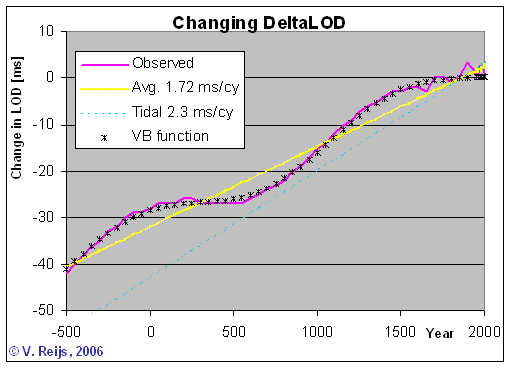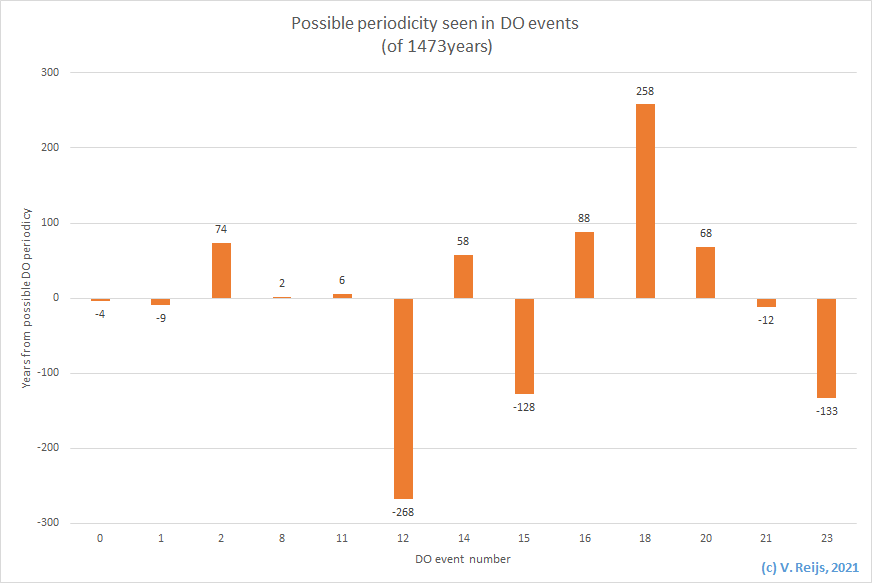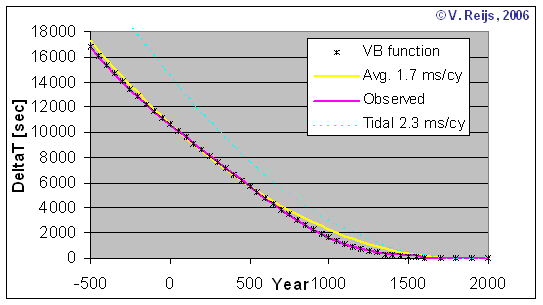Determining mean Length of Day and DeltaT formula
Using observed data for 500 BCE to 1600 CE from
[Morrison&Stephenson, 2004] and for 1650 CE to 1990 CE from IERS,
in the below section the change in LOD
and Delta T are described.
Content
Mean Length of Day (LOD)
The following mean changes in Length of Day (LOD) are depicted in
the below figure:
- Observed mean changes [Morrison&Stephenson, 2004] in LOD
(pink wavy line) (from 1650 CE is are quite accurate values)
- Tidal friction influence (straight light blue dotted line) of
2.3 [ms/cy] [Stephenson, 1997,
page 513]
- Optimized mean changes in LOD (black crosses), this is as per
my optimized function (using Simplex method with one linear and
one periodic term).
The mean Solar Day function is also incorporated in the Excel XLA file for
archaeoastronomy and geodesy functions.
- Average mean changes in LOD (yellow straight line), is around
1.72 [ms/cy], using my own Simplex optimized function. This is
within the value range (1.70+/-0.05 [ms/cy]) as provided in
Stephenson ([1997], page 514)
Interesting to see that there looks to be
a periodicity of around 1440 and 1550 years (also mentioned by
Stephenson ([1997], page 516), if
people know such a cycle and have some proof due to an
astronomical/geophysical process, let me know.
It could be this periodicity is caused by the splining
methodology used (based on the ideas of Slutzky [1937]),
but
I doubt that.
Another reason for a spurious periodicity could be due to the
sampling of only a limited amount of eclipses (Stephenson's pool of
observations), but I think that that would not results in such a
long term periodicity, because:
- I am thinking that the Nyquist-Shannon
theory
of
sampling and low pass (anti-aliasing) filtering could be
related to this idea. If this low pass filtering does not happen
at half the Nyquist sampling frequency one could get spurious
frequencies (fsample +/- factual) in the
relating analysis.
- Assuming say an on average sampling of every 6 years an
eclipse (pool of 400 observations over a period of 2300 years).
- to get a spurious periodicity of 1550 years in an analysis, an
actual periodicity of some 5.98 or 6.02 years (1/1550 = 1/6 +/-
1/actual) must exist in the real LOD (which is not 'filtered
out'). Such a natural(/actual) periodicity is not likely, IMHO.
- furthermore the splining in 5 knots would also not stimulate
such a long term periodicity over all knot intervals (the spurious periodicity
would even vary much more per knot interval; because the amount
of observations varies greatly per knot interval).
- In the above I used a uniform distribution of the observation,
while in actual live it are random observations, but still the
large variation of observation per knot interval would not give
such a visible uniform long term periodicity over all knot intervals.
- A test, if this periodicity is spurious, is by deliberately
changing the number of observations (larger spacing between
observations) and see if the periodicity changes in duration. If
it is spurious, the periodicity must change according to the
(1/spurious = 1/sample +/- 1/actual) formula.
Linking the seen periodicity with possible
geophysical or celestial events
Stephenson [Stephenson, 1997,
page 513] gives an possible explanation what causes the periodicity:
With
regard
to the quasi-periodic fluctuations on a timescale of some 1500
years, a possible mechanism would appear to be electromagnetic
coupling between the core and the mantle of the Earth. This is
the most likely cause of the decade fluctuations (Lambeck, 1980,
p. 247).
A possible other reason might be the Dansgaard-Oeschger
(DO)
warming events (with a possible solar origin),
which are events spaced by 1473 years, see also Bond [1997] (which is close to my determined
periodicity value of 1440 and 1550 years). These events can be seen
in Greenland ice cores and relate to glacial periods. And I think
that such climate events can impact the amount of ice and thus the
momentum of the Earth; thus possibly its rotation. Some researcher
also see the 1470 as a superimposition
of the 210 and 87 year cycles that can be recognised in
respectively the DeVries-Suess and Gleissberg solar cycles [Braun,
et al, 2006]. Is it important to note that the DO events seem not to
have an effect on the climate in the holocene (aka present past),
but the 'clock' behind DO events still exists (Rahmstorf, Pers.
comm. 2016).
The astronomical year of a DO warming event is on -9655 -
1473*event#
With: event# = an positive/negative integer
The periodicity of DeltaT seems to reach zero around 1820 CE, so
that a DO warming event# would be between -7 or -8 (-7.8 to be
specific).
Another possible reason given by Lamb is the change of sea-level
variations (Lamb, 1982); "as
significant long-term alterations in climate have been detected in
the last few milennia". In earlier publications Lamb (1972,
pp 220) is more specific: quoting Stacey (and Pettersson) about
maximum tide-generating forces happening with an approximate period
of 1670 years due to a perihelion-node-apside cycle [Pettersson,
1914, pp2].
This can be checked using the FDM method, described here, looking at Anomalistic Year
(related to Earth's perihelion), Draconic Month (related to Lunar
nodal cycle) and Anomalistic Month (related to Lunar apse cycle).
This gives a beat period of around 1250 Years (for epochs: around
1000 to 2000). So this is a different periodicity than mentioned by
Pettersson.
Is this perihelion-node-apside cycle another reason for the possible
periodicy in DeltaT?
So there are some different periods mentioned: DO events; 1473Years
or perihelion-node-apside cycle; 1670Years [Pettersson/Stacey] and
1250Years [Reijs].
Mean Delta T
The below mean DeltaT graph is determined using the my above change
in LOD formula. The following graphs are depicted:
- Observed mean DeltaT [Morrison&Stephenson, 2004] (pink
line)
- DeltaT due to tidal friction influence (straight light blue
dotted line) [Stephenson, 1997,
page 513]
- Optimized mean DeltaT (black crosses), this is as per the
integral of my change in LOD function
This mean DeltaT function is also incorporated in the Excel XLA file for
archaeoastronomy and geodesy functions.
- The average mean DeltaT (yellow line) based on LOD change of
around 1.7 [ms/cy] is also depicted
The DeltaT formula
Using Stephenson&Morrison [2004]
as the basis (n.dot = -26"/cy^2):
StartYear = 1820 [year]
Average = 1.80 [msec/cy]
Periodicity = 1443 [year]
Amplitude = 3.76 [msec]
Y2D = 365.25
OffSetYear = (JDutfromDate(StartYear, 0) - JDNDays) / 365.25
DeltaTVR = (OffSetYear ^ 2 / 100 / 2 * Average +
Periodicity / 2 / Pi * Amplitude * (Cos((2 * Pi * OffSetYear /
Periodicity)) - 1)) * Y2D [msec]
Can eclipses provide a clue around ndotreal?
Solar/lunar eclipses can not provide the real-life value of the
lunar accleration (ndotreal). The argumentation is as
follows:
- An ephemeris is made using a certain physical model and that
physical model will result in the (likely) locations of
celestial bodies.
- One has to start with a reasoanble accurate physical mode.
Furthermore ephemerii will evolve over time (an iterative
process).
- From that physical model one can determine if a celestial
object has an accelaration over a long period. In that way one
can determine e.g. the ndoteph (secular accelaration)
of the Moon for that particular physical model/ephemeris.
- So an ephemeris has such secular acceleration parameter (most
of the time implicitly) included.
- Using any ephemeris with a certain ndoteph, one can
calculate when the eclipse happens by varying the DeltaT (only
valid for that for that ephemeris). This will give a time
interval when it can be witnessed (this has been redone by the
author for some 80% of Stephensons' documented eclipses
(Stephenson, 1997)).
- The DeltaT value/formula always needs to be accompanied by an
ndotref value. Without such an ndotref
value a DeltaT formula is worthless.
- Remember the ndotref belonging to DeltaT formula is
just a reference parameter, nothing more. One can always convert
a DeltaT formula to another ndotconvert
(Morrison&Stephenson, 2012; updated formula from
McCarthy&Babcock, 1986):
ΔTconvert
= ΔTref - 0.910747 * (ndotconvert
- ndotref) * t2
where: t =
(decimalisedyear-1955.5)/100
- If the ndot in real life or in an ephemeris is different than
ndotref, one would still have an eclipse when one
converts the DeltaT values to this different (possible
real-life) ndot.
- DeltatT formula evolves over time (due to finding more eclipse
events e.g. (Stephenson, 1997) and (Huber, 2004); and/or finding
a more accurate physical model behind DeltaT).
- For eclipse determination: it is not important to know the
ndotreal, as long as one converts the DeltaT value to
the ephemeris' ndot.
- It is essential to realise that the above methodology does not
provide the ndotreal, the above methodology only
provides an ndot based on a physical model and a DeltaT based on
a specific ndot.
- The ndotreal is only reductable from a theory (like
within the underlaying ephemeris model) and/or matching on
recorded observations.
- I doubt if eclipse events can be the tool to determine the
ndotreal (as one can match an eclipse with many
combinations of physicalmodel/ephemeris/ndot and DeltaT
formula).
IMHO, the physical models we have are not yet good enough to
describe the reality around the ndot. I am not able to judge if the
lunar secular acceleration (ndotreal) is definitely as determined by LLR/etc:
-25.858 "/cy2 (Chapront et al., 2002) or the lunar
sidereal secular acceleration is -30.128 "/cy2
(Henriksson, 2017). I hope
astrophysic's experts can help, let me know.
New publication by Stephenson, et al.
Comparing the above derived parameters with the published values
by Stephenson [2016, formula 5.1]:
Parameter
|
DeltaTVR [Reijs,
2006]
|
Stephenson [2016]
|
StartYear [CE]
|
1820
|
1825
|
Average LOD growth [msec/cy]
|
1.80
|
1.78
|
Periodicity [Year]
|
1443
|
1500
|
Amplitude [msec]
|
3.76
|
4.0
|
References
Bond, Gerard, Showers William, Chesby Maziet, Lotti Rusty, Almasi
Peter, deMenocal Peter, Priore Paul, Cullen Heidi, Hajdas Irka,
and Bonani Georges, 'A pervasive millennial-scale cycle in North
Atlantic holocene and glacial climates', Science 278, no. 5341
(1997): 1257. http://ruby.fgcu.edu/courses/twimberley/EnviroPhilo/BondPap.pdf
Braun, Holger, Marcus Christl, and Stefan Rahmstorf. 2005.
'Possible solar origin of the 1,470-glacial climate cycle
demonstrated in a coupled model', Nature, Vol 438: pp. 208-11.
Chapront, J. et al.: A new determination of lunar orbital
parameters, precession constant and tidal acceleration from LLR
measurements. In: Astron. Astrophys 387 (2002), pp. 700-709.
Henriksson, Göran The acceleration of the Moon and the universe:
The mass of the graviton. In: Advances in Astrophysics 2 (2017),
issue 3, pp. 184-196. http://www.isaacpub.org/images/PaperPDF/AdAp_100064_2017041816162617572.pdf
Huber, Peter J. and Salvo de Meis: Babylonian eclipse observations
from 750 BC to 1 BC. Trans. by, Mimesis 2004.
Lamb, H.H. 1972. Climate: Present, past and future (London:
Methuen & Co).
McCarthy, Dennis D. and Alice K. Babcock: The length of day since
1656. In: Physics of the Earth and Planetary Interiors, 44 (1986),
pp. 281-292.
Morrison, L.V. and R.W. Stephens: Observations of secular and
decade changes in the Earth's rotation. In. Anny Cazenave (ed):
Earth rotation: Solved and unsolved problems. Springer
Netherlands 2012. pp. 69-78.
Morrison, L.V., and F. Richard Stephenson. 2004. 'Historical
values of the Earth's clock error Delta T and the calculation of
eclipses', Journal for the History of Astronomy, Vol 35: pp.
327-36.
Nautical Almanac Office: The Astronomical Almanac for the year
2014: And Its companion the Astronomical Almanac Online. Trans.
by, U.S. Government Printing Office 2013.
Pettersson, O. 1914. "Climatic variations in historic and
prehistoric time." in Svenska Hydrografik-Biologiska Kommissions
Skrfiter, Vol 5. Göteborg.
Rahmstorf, Stefan. 2003. 'Timing of abrupt climate change: A
precise clock', Geophysical research letters, Vol 30: pp. 17-1,
17-4.
Reijs, Victor M. M. 2006. 'Determining mean Length of Day and
DeltaT formula', in http://www.archaeocosmology.org/eng/DeltaTeval.htm
[accessed 30 May 2006].
Slutzky, Eugen. 1937. 'The summation of random causes as the
source of cyclic processes ', Econometrica, Vol 5: pp. 105-46.
Stephenson, F. Richard. 1997. Historical eclipses and Earth's
rotation (Cambridge University Press).
Stephenson, F. Richard., Leslie V. Morrison, and Catherine Y.
Hohenkerk. 2016. "Measurement of the
Earth's rotation: 720 BC to AD 2015." in Proceedings of the
Royal society, Vol 472. in http://rspa.royalsocietypublishing.org/content/472/2196/20160404.
Conclusion
The parabolic formula provided by Stephenson to calculate the mean
DeltaT is perhaps lacking enough elements to predict the DeltatT (or
LOD) accurate enough over the whole time period of 500 BCE to say
1300 CE (differences smaller than 10%). This additional periodic
term in the formula gives a better mapping to the table of
Morrison&Stephenson than only a parabolic formula.
The periodic formula published [Stephenson, 2016] compares very well
with the earlier derived formula [Reijs, 2006]: there is not that
much difference in these parameter values. Reijs gives a possible reason for this periodicity: Dansgaard-Oeschger
(DO)
warming events.
The periodic formula has also been implemented in Stellarium
since 2013. If you want to test the formula (one can use Excel XLA file), let me know.
Major content related
changes: May 3, 2006


